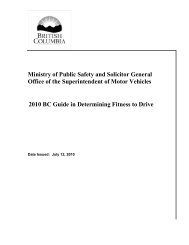Community Accountability Programs Information ... - Ministry of Justice
Community Accountability Programs Information ... - Ministry of Justice
Community Accountability Programs Information ... - Ministry of Justice
- No tags were found...
You also want an ePaper? Increase the reach of your titles
YUMPU automatically turns print PDFs into web optimized ePapers that Google loves.
After the process is complete, the board decides on appropriate reparationmeasures. An agreement is then drawn up that the <strong>of</strong>fender is expected t<strong>of</strong>ulfil. A panel member is chosen to act as a mentor for the <strong>of</strong>fender andensure that the terms <strong>of</strong> the agreement are completed. Once the agreementhas been fulfilled, a final meeting takes place between the panel and the<strong>of</strong>fender. At this meeting the panel congratulates the <strong>of</strong>fender forcompleting the agreement and making amends. The meeting also brings theincident to a close and assures the <strong>of</strong>fender <strong>of</strong> his or her continuedmembership in the community.With volunteers acting as mentors for <strong>of</strong>fenders, this model encourages ahigh degree <strong>of</strong> community participation and commitment. Note, however,that while “justice committees and panels almost certainly embrace theaims <strong>of</strong> restorative justice … they fall short <strong>of</strong> the practice <strong>of</strong> restorativejustice when panel members make decisions on behalf <strong>of</strong> the victim,<strong>of</strong>fender, and the community most closely affected by a crime.” 1 Includingall parties (victim, <strong>of</strong>fender, and the community) increases the restorativenature <strong>of</strong> this model.Staying true to the vision <strong>of</strong> restorative justiceThe Province <strong>of</strong> BC does not endorse any particular restorative justicemodel but supports the adoption <strong>of</strong> restorative approaches as a generalobjective. If your community decides to develop its program along the lines<strong>of</strong> one model, you may incorporate elements from other models that meetyour community’s needs.Regardless <strong>of</strong> the model you select, keep in mind the key elements thatdefine restorative justice programs. Asking yourself the following questionswill help you express the essence <strong>of</strong> restorative justice: 2• Who has been hurt?• What are their needs?• Whose obligations are these?1 Susan Sharpe. Restorative <strong>Justice</strong>: A Vision for Healing and Change. Edmonton: EdmontonVictim Offender Mediation Services, 1998, p. 38.2 Howard Zehr. The Little Book <strong>of</strong> Restorative <strong>Justice</strong>. Intercourse, PA: Good Books, 2002,p. 38.Restorative <strong>Justice</strong>: Promoting <strong>Community</strong>-Based Responses to Crime 12
















